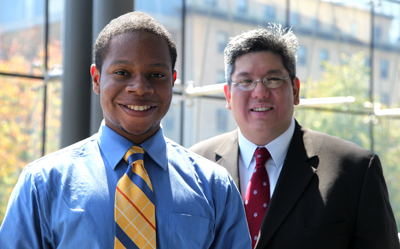BWH Researchers Devote Summer to Mentoring Undergraduates, Furthering Translational Science

Malcolm Reid and Alexander Lin |
With summer in its final stretch, three BWH researchers and their undergraduate mentees will look back fondly on the last few months spent bringing bench science closer to the bedside. Alexander Lin, PhD, of Radiology, and Neurology's Francisco Quintana, PhD, and Lior Mayo, PhD, served as mentors in the Summer Clinical and Translational Research Program (SCTRP) at Harvard Medical School. The 10-week program is designed to broaden underrepresented minority and disadvantaged college students' understanding of clinical and translational research.
Reducing Human Error
Lin and his mentee Malcolm Reid Jr., a junior at Princeton University, spent the summer improving upon a tool that will eventually make it easier for clinicians to diagnose various diseases. Magnetic resonance spectrometry (MRS) is a non-invasive technique used to study metabolic changes in different bodily conditions, such as mild traumatic brain injury, heart disease and neurodegenerative disorders. The duo worked on a novel two-dimensional version of MRS, known as COrrelated SpectroscopY (COSY).
Reid helped to improve the post-processing pipeline to read and process raw data from COSY. Lin notes that Reid's software improvements (known as autoCOSY) will reduce processing time and human error, which likely occurs when having to analyze copious amounts of data. For instance, it takes 12 minutes for a human to process raw COSY data, whereas Reid's semi-automated method can perform the same task in seven minutes.
Although COSY and the post-processing pipeline are still in their experimental stages, Lin suspects that the tools will be available for clinicians to use in clinical trials within the next year.
So how has it been for Lin and Reid to work side-by-side on a tool that may revolutionize the way clinicians diagnose some of the nation's most common diseases? Impactful and interdisciplinary.
"The undergraduate students from the SCTRP program, like Malcolm, operate easily on a post-doc level in terms of intelligence and their ability to do things. Malcolm's work has had a significant impact on our clinical program."
"Dr. Lin really shows how interdisciplinary research is," added Reid. "I learned the many sides of research-physics, biology, medicine and programming. Research is a team effort. I appreciate working in Dr. Lin's lab because he makes you feel like you are actually helping to bring the next generation of magnetic resonance spectroscopy to the clinic."
Pinpointing MS Pathway
 |
| Nadya Ali, Francisco Quintana and Lior Mayo |
Quintana, Mayo and their mentee Nadya Ali, a senior at the University of Washington, focused their research efforts this summer on establishing a foundation for future therapies for multiple sclerosis (MS). The three studied the signaling pathways that contribute to central nervous system inflammation, thereby leading to MS. Ali produced valuable results showing that lactosyl-ceramide, a type of lipid, plays a role in promoting both adaptive and innate proinflammatory immune responses.
In the adaptive immune response pathway, Ali found that lactosyl-ceramide boosted the differentiation of effector T cells that drive inflammation in the central nervous system. In the innate immune response pathway, Ali demonstrated how lactosyl-ceramide activated both microglial and astrocyte cells (cells of the brain and spinal cord) that promote neurodegeneration.
"Nadya's work fits into the big picture of what my lab is studying regarding astrocytes and signaling pathways that contribute to CNS inflammation," said Quintana. "This research has helped identify mechanisms of pathogenesis and might help scientists develop new therapies for MS."
In terms of working as a team, Nadya sees Quintana and Mayo as not only mentors, but educators.
"They taught me about not only the practice of research, but how to ask the right questions," said Ali. "Also, working in the lab reinforced the idea that research is not just an independent thing, it is very team-oriented."
Quintana and Mayo credit their own early years in research as the reason behind their interest in participating in SCTRP.
"Francisco and I participated in a program like SCTRP early in our careers. It helped us figure out if working in research would be suitable for us," said Mayo. "Now, we want to help the next generation of students find out if research is right for them by offering them opportunities to work in a real lab environment."